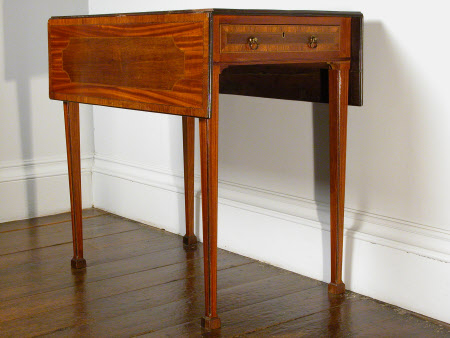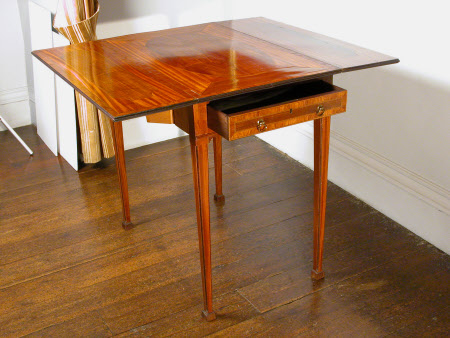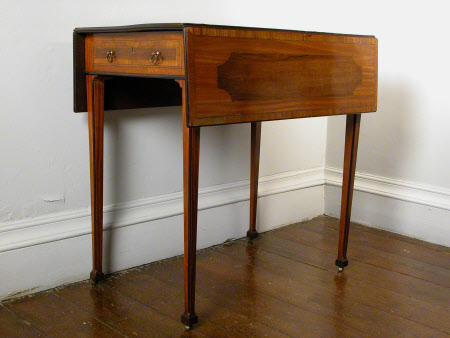Untitled
Henry Kettle (fl. c.1773 - 1797)
Category
Furniture
Date
circa 1770 - circa 1775
Materials
Satinwood, mahogany, kingwood, oak, brass
Place of origin
18, St. Paul's Churchyard
Order this imageCollection
Saltram, Devon
NT 871330
Summary
A pair of satinwood and mahogany-veneered Pembroke tables, English, circa 1770 - 1775, by Henry Kettle (d. 1797). Each having a rectangular top and pair of drop-leaves crossbanded in kingwood. The top with an oval reserve of mahogany veneer, the drop-leaves each with a cut-cornered rectangular reserve of mahogany veneer. The cockbeaded and crossbanded frieze drawer with brass axe-head handles. Raised on four tapering square-section legs topped by small shaped spandrels, edged with ebonized angles and with square block feet raised on brass castors.
Full description
One table contains the trade label of Henry Kettle. It notes that he was a ‘cabinet maker, upholder and undertaker’ working ‘at no 18 in St Paul’s Churchyard’ – a popular location for cabinetmakers of the period. This address suggests that the tables may have been made between 1770 and 1775, by which time Kettle had moved his main production to No. 23. The authorship of these tables remained a mystery until the 1960s when a makeshift repair – a long screw stabilising one of the legs which mistakenly impeded the opening of the frieze drawer – was restored in a more sympathetic manner. Upon freeing the drawer the trade label of Henry Kettle was discovered in an excellent state of preservation. The same table bears a paper label reading 'Lady K. Parker', referring to Lady (Emily) Katherine Parker who inherited some of the contents of Whiteway, near Chudleigh, Devon. It is possible therefore that this table originally came from Whiteway, built by John Parker in the 1770s but occupied at the end of the 18th century and the beginning of the 19th century by Montagu Edmund Parker (1737 - 1813), father of Montagu Edmund Parker (d. 1831) and grandfather of Harriet Parker (1809 - 1897), Lady (Emily) Katherine Parker's mother. Surviving bills at Saltram, from 1796 and 1797, are headed ‘Oakley & Kettle’, suggesting a partnership with George Oakley at this time, although no piece has, as yet, been identified. Oakley also operated from premises in St Paul’s Churchyard.
Provenance
The paper label reading 'Lady K. Parker' to one of these tables suggests they were the property of Lady (Emily) Katherine Parker (1846 - 1910), daughter of the 2nd Earl of Morley and Harriet Sophia Parker (1809 - 1897) who bequeathed items to both of her children, Katherine, and Albert Edmund Parker (1843 - 1905), 3rd Earl of Morley. Harriet Parker was the grand-daughter of Montagu Edmund Parker of Whiteway, near Chudleigh, Devon. It is possible, therefore, that this table was originally at Whiteway and came to Saltram only after Lady Katherine's death in 1910. The tables could each have a different provenance, however, since early National Trust provenance index cards note that one came to the Trust via Treasury Transfer, whilst the other was part of the Endowment of 1962. One, therefore, probably at Saltram by 1951 and accepted by HM Treasury in lieu of full payment of Death Duty from the Executors of Edmund Robert Parker (1877 - 1951) and transferred to the National Trust in 1957. The other at Saltram by 1962 and part of the endowment given to the National Trust by Montagu Brownlow Parker (1878 - 1962), 5th Earl of Morley.
Makers and roles
Henry Kettle (fl. c.1773 - 1797), cabinetmaker
References
Wills, 1966: Geoffrey Wills. “Some labelled furniture at Saltram.” Furniture History 2 (1966).



